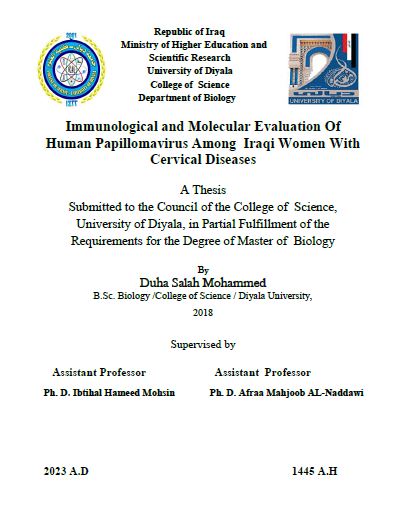المستخلص
This study was conducted from October 2022 to January 2023 at Baghdad Teaching Hospital in Baghdad, Iraq, with the approval of the Scientific Committee for Health, as indicated in letter number 3005 dated October 9, 2022.
The current study aims to detect the prevalence of the Human Papilloma virus among women who have Cervical Cancer, identify the relationship of the virus to cervical cancer, and determine the present genotype in Iraq by collect 89 samples and 40 control were taken in the period from October 2022 to January 2023 contain cervical swaps and vein blood from the patients after diagnoses in Early Detection Clinic in Baghdad Teaching Hospital by Gynecologist.
Immunological detection used Enzyme Linked Immunosorbant Assay (ELISA) technique to detect Anti-HPV Immunoglobulin M were 19 (21.3%), InterLuekin-10 mean which were 2.223 for patient and 2.035 for healthy with significant difference (P < 0.001), and Tumor Necrosis Factor α TNF levels were higher in patients than healthy which were 2.650 for patient and 2.384 for healthy with significant difference (P < 0.001).
Molecular Detection used Polymerase Chain Reaction assay (PCR) for positive HPV (19) and detect the HPV16 genotype (57.89%) and for the HPV6 genotype (10.52%) but negative for the genotypes (HPV-11,18,45). HPV 16 and HPV 6 are common in cervical cancer Iraqi women. Were presented for sequencing to determine the genotype of HPV with regard to the E6 gene in the human papillomavirus type-6, the results indicated the presence of one nucleic acid variant in both investigated samples S1 and S2 (namely 124A>C). With regard to the E6 gene in the human papillomavirus type-16, our results indicated the presence of one nucleic acid variant in both investigated samples S2, S3, S4, S5, and S10 (namely 225G>T). The translation of these variants to amino acid residues showed that both nucleic acid substitutions showed silent effects on the entire length of the encoded protein, respectively (p.74I= and p.117 L=). It was inferred from the generated phylogenetic trees that there were vast phylogenetic distances found between our sample’s clade and the other types of the same viral organism as distinct phylogenetic distances were identified between the type-6 and type-16 and the incorporated out-group sequences.
The phylogenetic tree of type-16 isolates showed the presence of variable phylogenetic distances between type-6 sequences and type-11, type-9, type-43, type-7, type-44, and type-74, respectively. Whereas the phylogenetic tree of type-6 isolates showed the presence of variable phylogenetic distances between type-16 sequences and type-26, type-34, and type-70, respectively. Therefore, on this basis, drew phylogenetic tree for these genotypes.
The current study conclude the IL-10, TNF -α level, anti-HPV IgM were have high sensitivity and specificity in diagnosing patients from control by ELISA, levels were higher in patients than healthy with significant difference. HPV-16 and HPV-6 were the most frequent genotype in present study with identification indicates that our women are at risk of developing cervical cancer.





